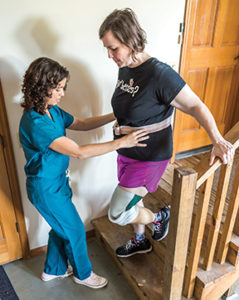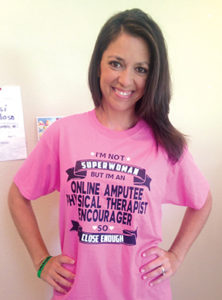By Élan Young
When Cosi Belloso talks about her profession as a physical therapist (PT) who serves the amputee community, her buoyant passion and commitment bubble up. This, despite that she has had to go against the grain in the healthcare profession to prove that there is a need to specialize in amputee care and a way to serve the community outside the limitations of the insurance system.
As a physical therapist for 16 years, she got her start as a graduate student at the world-class Jackson Memorial Hospital in Miami, which, until recently, ran an amputee outpatient clinic. Because Jackson Memorial had broad offerings, they made the rookie PTs go through every program. Belloso got to see patients in level 1 trauma ICU, neonatal, burn trauma, wound care, orthopedic trauma, spinal cord injury, and other areas–including amputee outpatients.
A few years into her career, she got the amputee rotation. “For whatever reason, at this hospital, no one wanted the rotation,” she says. “I was very nervous myself since I didn’t have a lot of training.” Then, an incredible thing happened.
Curtis Clark, a renowned amputee rehab specialist (who also mentored acclaimed physical therapist Bob Gailey) took time away from his schedule to personally mentor Belloso. While she had received some education in school about providing treatment for amputees, much of the field requires observing patient after patient and learning all the nuances of each situation. “His passion helped fuel me,” she says. “I loved to learn, and he loved passing on his knowledge to someone who was eager. It was a really well-run program.”
Although the amputee outpatient clinic there has been scaled back considerably, she looks back on those years as precious learning opportunities because she saw more during her stint at Jackson Memorial than some PTs see in their entire careers. “It was beyond an education,” she says.
Belloso moved from Miami to Tampa to be closer to family and had four children within six years. During that time, she worked for Tampa General Hospital as well as in the home health sector. She desperately wanted to use her knowledge to help amputees specific-ally, but whenever she knocked on hospital doors offering to build an outpatient program, they would respond that they weren’t interested. “They sometimes said there wasn’t a need, but that was baloney,” she says. “The truth is, it wasn’t lucrative for them.”
Life threw her a curveball when she was diagnosed with breast cancer. By the time Belloso emerged from this crisis nearly a year later, she knew she wanted to pursue her passion for providing physical therapy for people with amputations, but she didn’t know how.
It was encouragement from Greg Todd, a former classmate who had a private practice, that taught her a new way to think about her options. He became her next mentor, but this time for business. With a pair of parallel bars that were unused in his practice and space in his building that she could use to see patients, she opened her clinic—exactly one year after she had her mastectomy.

Private practice allowed Belloso to arrange her life around her primary role as a mother and to serve amputees in a way that offers more one-on-one care than typical outpatient clinics provide for amputees.
Because of the way healthcare insurance is structured, it would not be feasible to operate the business if Belloso accepted insurance. In fact, she found that healthcare reimbursement is a significant factor in why there is no dedicated amputee specialty at the national level in her profession.
Belloso explains the conundrum that many people with insurance pay a $40 to $100 copay per visit at an outpatient clinic, so they are already paying almost private-level premiums. However, if they use their insurance, they may have therapy with four to six other patients at once, with no one-on-one treatment and no amputee specialist. Additionally, the insurance may only give them six visits when they might need 12 to 20.

In her 15-minute, complimentary discovery consultations, nine out of ten patients will come to understand what it means to get an hour of one-on-one care and get the full round of therapy that they need. It means they can get back to work, back to being active with their kids, or back to doing the hobbies and things they love.
In trying to do some marketing on Facebook, she realized an enormous gap in both PTs’ and consumers’ education. She started answering a lot of questions on amputee care, getting resistance from professionals, amputees, and their caregivers before then getting noticed for having something important to teach. Soon, a private support group on Facebook asked her to host a weekly live feed where she answered questions; it quickly grew to two nights per week. Before long, she moved the live feed to her CosiTalks Facebook business page, so the information could be more easily accessible outside of private groups.The primary goal of her show is to provide a free resource where those recovering from limb loss can ask their questions. Topics of discussion cover anything and everything. She also has expanded to include corporate-sponsored discussions of prosthetic products. This is all on top of actually seeing patients. It keeps her busy, but it’s also rewarding.
“People from all over the U.S. and all over the world now tune in to watch,” she says. “People can get to know me there. I ask people to send me their questions, and I try to cover as much territory as I can. Sometimes it’s frustrating to not be near someone who needs help, but I am able to put them in touch with people in their area who can support them.”
Understanding how deep and wide the gap is for quality PT care has helped Belloso take her education and use it to spread hope and education to others. And it’s also given her an advantage as a PT with a niche audience. With about 400 to 600 amputations per day occurring in the United States, the need for quality amputee care is on the rise. Belloso takes that news soberly and plans to make instructional videos to further spread her knowledge and help guide a growing and underserved population.
For more information, visit www.palancapt.com and www.facebook.com/cositalks.
TOP IMAGE: Belloso with Reggie Showers, a bilateral below-knee amputee who flew in to be interviewed on CosiTalks.



